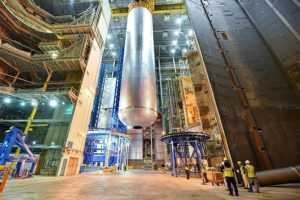Liquid Hydrogen Definition, Properties, Production, and Storage
Liquid hydrogen is a colorless liquid composed mainly of hydrogen, and which can be used as a fuel. The liquid hydrogen definition, properties, production and storage are discussed in this article as outlined below;
-Liquid Hydrogen Definition: 6 Ways to Define Liquid Hydrogen
-Formula and Physical Characteristics of Liquid Hydrogen
-Process of Liquid Hydrogen Production
-Isomeric Forms of Liquid Hydrogen
-Liquid Hydrogen and Fuel Cells
-Liquid Hydrogen Storage and Transport
Liquid Hydrogen Definition: 6 Ways to Define Liquid Hydrogen
Liquid hydrogen (LH) is the product of cryogenic hydrogen liquefaction; a process which converts gaseous hydrogen to the liquid state; through physicochemical changes.
The above definition highlights the basic physical attribute of LH, and uses it as a defining factor. A more detailed definition based on physical properties is as follows;
Liquid hydrogen is a colorless, odorless, tasteless, noncorrosive and flammable liquid, which is produced from hydrogen under cryogenic (low-temperature) conditions, and is most stable at temperature of around -253°C.
The stability of LH at around -253°C (or -423°F) is due to the fact that this is the temperature at which hydrogen liquefaction occurs.
In the foregoing definition, it is mentioned that LH is a flammable substance. This attribute implies that it may have prospects as a fuel. Given that hydrogen is the most abundant element in the universe [8], using its liquefied form as a fuel, suggests a step in the direction of renewable energy development and global sustainability.
The following liquid hydrogen definition views the substance as a source of energy;
Liquid hydrogen is a flammable substance composed primarily of hydrogen, which has an energy density of up to 2.3 kWh per liter and can be used as a fuel in automobiles, and for electricity generation in fuel cells [1].
As a prospective energy source, LH may be described within the same context as renewable alternatives like wind, geothermal and solar, as well as energy sources of high abundance such as nuclear.
However, there are arguments that liquid hydrogen might not be a sustainable or clean energy source. These arguments are mostly based on the resources used in the production of LH, which include fossil fuels, and biomass [12].
The use of such resources can contribute to environmental degradation by emitting greenhouse gases and other byproducts that reduce air quality. As a result of this, the practice of green hydrogen production attempts to use renewable, clean resources to produce liquid hydrogen [13].
Within the context of its applications, liquid hydrogen definition is given below;
Liquid hydrogen is the primary product of hydrogen liquefaction, which is used in aerospace engineering, automotive energy supply, nuclear propulsion, industrial refining, energy production, and welding, among other applications.
Storage and transport conditions can also be used to describe liquid hydrogen.
Generally, hydrogen can be stored in a variety of forms that include hydride, reformed fuel, adsorbed hydrogen, liquid hydrogen, and compressed gas [1].
In terms of the ease of handling; liquid hydrogen is one of the most viable of these storage forms. On the other hand, storage of hydrogen gas is possible only in highly-pressurized tanks in the order of 5,000 to 10,000 psi [9]. Liquid hydrogen definition as a sustainable storage state, is given below;
Liquid hydrogen is the liquefied form of hydrogen, which is relatively easy to store and transport in cryogenic tanks at temperature of approximately -253°C(-423°F) or 20 K, and pressure of 1.013 bar.
Lastly, liquid hydrogen can be defined as an energy alternative to hydrocarbons;
Liquid hydrogen is a flammable liquid derived from the cryogenic liquefaction of gaseous hydrogen, and which is a potential replacement to hydrocarbons and other unsustainable energy resources.
Formula and Physical Characteristics of Liquid Hydrogen
The following table shows some important properties of liquid hydrogen;
| Liquid Hydrogen Properties | |
| Phase | Liquid |
| Chemical Formula | H2(l) |
| Color | None |
| Odor | None |
| Taste | None |
| Density (Kg/m3) | 71.0 [10] |
| Energy Density (kWh/l) | 2.3 – 2.8 |
| Pressure (atm) | 1.0 [1] |
| Boiling Point | -423°F / -253°C / 20 K [16] |
| Melting Point | -434°F / -259°C / 14 K |
Process of Liquid Hydrogen Production
Liquid hydrogen is made by hydrogen isolation and liquefaction at low temperature and standard pressure.
The two steps in the overall process of LH production are isolation and liquefaction. These are discussed below;
1). Hydrogen Isolation in the Production of Liquid Hydrogen
Although it is a highly abundant element, hydrogen does not naturally occur in its native form [7]. As a result, to derive pure hydrogen, the element must be isolated from its compounds, which include water, biomass, ammonia and fossil fuels.
The main methods of hydrogen production or isolation are electrolysis, reactive distillation, dissociation and reforming.
In electrolysis, hydrogen is isolated from water, by using electricity to split (or decompose) water into its component elements; oxygen and hydrogen [4].
The process occurs in an electrolytic cell or ‘electrolyzer’. Nickel may be used as the anode; while the cathode is often made of an alloy such as Cobalt-Phosphorus (Co-P) [6].
Usually, hydrogen is isolated at the cathode by water reduction, while oxygen is isolated at the anode by oxidation of water. These are referred to as the Hydrogen Evolution Reaction (HER), and the Oxygen Evolution Reaction (OER) respectively, and they represent the electrochemical half-reactions involved in the isolation/production of hydrogen from water.
The electrolytic method of hydrogen isolation can be made sustainable, as renewable sources can be used to provide electricity for the reaction [11]. Under such circumstances, the hydrogen gas produced is referred to as ‘green hydrogen’.

On the contrary, steam-reforming is a relatively-unsustainable process which makes use of nonrenewable resources like hydrocarbons [17].
Hydrogen isolation by this method may involve the release of carbon dioxide; a greenhouse gas; into the atmosphere. Under such circumstances, the hydrogen produced may be referred to as ‘grey hydrogen’ [15].
Natural gas is the main feedstock for steam reforming, and makes up about 48% of overall hydrogen production, while 30%, 18%, and 4% are allocated to petroleum distillation, coal gasification and electrolysis respectively [5].
In steam reforming, the feedstock is made to react with steam under controlled physicochemical conditions, to produce hydrogen, alongside byproducts like carbon dioxide and carbon monoxide. A catalyst is usually present, to drive the reaction process.
Biomass and its derivatives (like ethanol) may also be used as feedstock in liquid hydrogen production. The steam reformation method is relatively inexpensive, but may contribute to environmental degradation.
In reactive distillation, a hydrogen-rich substrate is made to react with vapor while undergoing distillation. Hydrogen Iodide (HI) solution is usually utilized in this process [2].
Dissociation method is similar to electrolysis, as it is based on the chemical breakdown of hydrogen-rich compounds. However, the dissociation method can apply a broader range of chemical setups including reactive membranes [3].
Fuels rich in carbon and hydrogen can also be used as substrate in dissociation method of hydrogen isolation/production. The outcome of the process is controlled by physicochemical factors like pressure, temperature and chemical composition.
2). Hydrogen Liquefaction in the Production of Liquid Hydrogen
Liquefaction is the second and final step in the process of liquid hydrogen production. It can also be described as the most crucial step.
The critical point (point of liquid-gas equilibrium) of hydrogen occurs at 33K [19]. In order to liquefy this element, it must be cooled below the critical point, to about 20K/253°C/423°F.
What this implies is that the main objective of hydrogen liquefaction is to reduce the temperature of hydrogen gas, thereby producing liquid hydrogen. It is a cryogenic process which usually occurs in a temperature-regulated compressor.
Isomeric Forms of Liquid Hydrogen
The two isomeric forms in which liquid hydrogen occurs are ortho-hydrogen and para-hydrogen [18]. These isomers differ based on their spin configurations.
Ortho-hydrogen is less stable than para-hydrogen, and therefore may spontaneously transform to the latter through an exothermic process, under low-temperature conditions. Para-hydrogen is the more stable and common form of liquid hydrogen, and is more suitable for storage.
Liquid Hydrogen and Fuel Cells
Hydrogen fuel cells can make use of liquid hydrogen as an electrolytic substrate that is subjected to electrochemical reaction to generate electricity.
The process by which liquid hydrogen is utilized in fuel cells, is different from conventional combustion of fuels. Rather than undergoing thermal decomposition, liquid hydrogen undergoes electrochemical dissociation in a fuel cell.
One of the most common contexts in which liquid hydrogen serves as a fuel is in space exploration technology.
As a propellant fuel in space crafts and rockets, liquid hydrogen has some advantages such as high energy efficiency, low molecular weight and safety of handling.

Storage and Transport
One of the advantages of liquid hydrogen is its ease of storage and transport relative to hydrogen gas.
The storage and transport of hydrogen gas is not an energy-conservative approach, as it requires the use of high-pressure storage tanks in the order of 5,000 to 10,000 psi [14]. Because it is flammable, the transport of hydrogen in its gaseous form also poses the risk of an explosion hazard.
On the other hand, LH poses less risk and difficulty of storage and transport. The main requirement in such operations is effective regulation of temperature.
Liquid hydrogen tanks are cryogenic vessels equipped with heating, venting and cooling components, to maintain the temperature of hydrogen in its liquid form, while minimizing losses due to boiling of the fluid.
Various types of storage equipment for liquid hydrogen can be used. They are also usually designed to maintain internal pressure and thermodynamic stability.

Conclusion
Liquid hydrogen cannot exist in nature, because it requires the production and liquefaction of hydrogen gas, at low temperature and stable pressure.
The overall process by which liquid hydrogen is made, consists of two steps or stages; which are isolation and liquefaction.
Isolation is also referred to as ‘hydrogen production’, and involves the splitting of hydrogen-rich compounds including hydrocarbons, water and hydrogen iodide, to obtain gaseous hydrogen
Liquefaction occurs when the gaseous hydrogen that has been isolated, is subjected to low-temperature conditions (20 K), to convert it to liquid, below its critical point.
Liquid hydrogen can be used as a propellant in space crafts, as well as an energy source in fuel cells. It may release energy either through combustion of electrochemical reaction.
The storage and transport of liquid hydrogen requires specialized cryogenic tanks which are equipped with temperature and pressure control components.
References
1). Aziz, M. (2021). “Liquid Hydrogen: A Review on Liquefaction, Storage, Transportation, and Safety.” Energies 14(18):5917. Available at: https://doi.org/10.3390/en14185917. (Accessed 10 June 2022).
2). Belaissaoui, B.; Hetreux, R. T.; Meyer, X.; Meyer, M.; Gerbaud, V.; Joulia, X. (2008). “Vapor reactive distillation process for hydrogen production by HI decomposition from H2O/HI/I2 solutions.” Chemical Engineering and Processing 47(3):396-407. Available at: https://doi.org/10.1016/j.cep.2007.01.018. (Accessed 13 June 2022).
3). Boersma, R.; Shindle, J. A. (2007). “Hydrogen Production by Dissociation of Water through a Novel Membrane.” Available at: https://www.researchgate.net/publication/264044881_Hydrogen_Production_by_Dissociation_of_Water_through_a_Novel_Membrane. (Accessed 13 June 2022).
4). Engge, Y.; Maulana, F.; Nurhuda, M.; Soeprivanto, I. (2021). “Dissociation of water into hydrogen and oxygen through a combination of electrolysis and photocatalyst.” IOP Conference Series Earth and Environmental Science 743(1):012054. Available at: https://doi.org/10.1088/1755-1315/743/1/012054. (Accessed 14 June 2022).
5). Franchi, G.; Capocelli, M.; Falco, M. D.; Piemonte, V.; Barba, D. (2020). “Hydrogen Production via Steam Reforming: A Critical Analysis of MR and RMM Technologies.” Membranes 10(1):10. Available at: https://doi.org/10.3390/membranes10010010. (Accessed 12 June 2022).
6). Givirovskiy G.; Ruuskanen V.; Ojala L. S.; Lienemann M.; Kokkonen P.; Ahola J. (2019). “Electrode material studies and cell voltage characteristics of the in situ water electrolysis performed in a pH-neutral electrolyte in bioelectrochemical systems.” Heliyon. 2019 May 14;5(5):e01690. Available at: https://doi.org/10.1016/j.heliyon.2019.e01690. (Accessed 12 June 2022).
7). Helmenstine, A. M. (2019). “Chemical Element Pictures – Photo Gallery.” Available at: https://www.thoughtco.com/chemical-element-pictures-photo-gallery-4052466. (Accessed 14 June 2022).
8). Helmenstine, A. (2020). “What Is the Most Abundant Element in the Universe?” Available at: https://sciencenotes.org/what-is-the-most-abundant-element-in-the-universe/. (Accessed 14 June 2022).
9). Hua, T. Ahluwalia, R.; Peng, J. K.; Kromer, M.; Lasher, S.; McKenney, K.; Law, K.; Sinha, J. (2011). “Technical assessment of compressed hydrogen storage tank systems for automotive applications.” International Journal of Hydrogen Energy 36(4):3037-3049. Available at: https://doi.org/10.1016/j.ijhydene.2010.11.090. (Accessed 14 June 2022).
10). Jiang, Z. (2022). “Feasibility Invetigation of Several Hydrogen Generation & Storage Methods.” IOP Conf. Ser.: Earth Environ. Sci. 1011 012017. Available at: https://iopscience.iop.org/article/10.1088/1755-1315/1011/1/012017/meta. (Accessed 14 June 2022).
11). Kwassi-Effah, C. C. (2015). “A Review on Electrolytic Method of Hydrogen Production from Water.” Available at: https://www.researchgate.net/publication/319666234_A_Review_on_Electrolytic_Method_of_Hydrogen_Production_from_Water. (Accessed 14 June 2022).
12). Longden, T.; Beck, F. J.; Jotzo, F.; Andrews, R.; Prasad. M. (2021). “‘Clean’ hydrogen? An analysis of the emissions and costs of fossil fuel based versus renewable electricity based hydrogen.“ Available at: https://www.researchgate.net/publication/352864087_’Clean’_hydrogen_An_analysis_of_the_emissions_and_costs_of_fossil_fuel_based_versus_renewable_electricity_based_hydrogen. (Accessed 14 June 2022).
13). Manohar, P.; Manohar, P. P. R.; Jhala, P. P. (2021). “Green Hydrogen-Energy source of the Future An analysis of the technology scenario.” Available at: https://doi.org/10.13140/RG.2.2.29947.64807. (Accessed 14 June 2022).
14). Ogden, J. M.; Yang, C. (2005). “Implementing a Hydrogen Energy Infrastructure: Storage Options and System Design.” Materials Research Society symposia proceedings. Materials Research Society 895(1458380). Available at: https://doi.org/10.1557/PROC-0895-G02-01. (Accessed 14 June 2022).
15). Oni, A. O.; Anaya, Y. K.; Giwa, T.; Lullo, G. D.; Kumar, A. (2022). “Comparative assessment of blue hydrogen from steam methane reforming, autothermal reforming, and natural gas decomposition technologies for natural gas-producing regions.” Energy Conversion and Management. Available at: https://doi.org/10.1016/j.enconman.2022.115245. (Accessed 14 June 2022).
16). Sun, X.; Guo, Z.; Huang, W. (2015). “Passive zero-boil-off storage of liquid hydrogen for long-time space missions.” International Journal of Hydrogen Energy 40(30):9347–9351. Available at: https://doi.org/10.1016/j.ijhydene.2015.05.184. (Accessed 14 June 2022).
17). Tugnoli, A.; Landucci, G.; Cozzani, V. (2008). “Sustainability assessment of hydrogen production by steam reforming.” International Journal of Hydrogen Energy 33(16):4345-4357. Available at: https://doi.org/10.1016/j.ijhydene.2008.06.011. (Accessed 14 June 2022).
18). Zhuzhgov, A. V.; Krivoruchko. O. P.; Isupova, L. A.; Martvanov, O. N.; Parmon, V. N. (2018). “Low-Temperature Conversion of ortho-Hydrogen into Liquid para-Hydrogen: Process and Catalysts. Review.” Catalysis in Industry 10(1):9-19. Available at: https://doi.org/10.1134/S2070050418010117. (Accessed 14 June 2022).
19). Züttel, A. (2004). “Hydrogen storage methods.” The Science of Nature 91(4):157-72. Available at: https://doi.org/10.1007/s00114-004-0516-x. (Accessed 4 June 2022).





